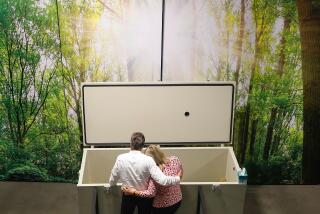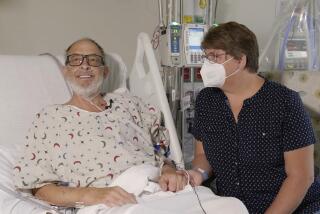Doctors Planning More Pig Liver Transplants : Medicine: Critics point out that comatose patient had no role in decision. Despite her death, team leader calls procedure a success.
- Share via
Researchers at Cedars-Sinai Medical Center on Tuesday were already considering doing more pig-to-human liver transplants even as bioethicists rekindled the longstanding debate about how far scientific research should be pushed in humans.
The reactions came in the wake of the death Monday of Susan Fowler, 26, of Burbank, about 30 hours after she received a pig’s liver to take over the functions of her own failing organ. The first-ever transplant of a pig’s liver into a human was undertaken to save her from certain death, but failed just as surgeons prepared to replace the animal organ with a human donor liver.
Dr. Leonard Makowka, who headed the historic transplant effort, said he deeply regretted Fowler’s death but viewed the pig-liver transplant as a scientific success, yielding information of significant value to the field of transplant medicine. Calling Fowler’s surgery the “entry of Cedars-Sinai into this area of medicine,” Makowka said his research group there intends to continue to use pig liver transplants as a means of buying time for patients awaiting human organs. He also said the research group is working on a genetically altered strain of pigs that would produce organs more closely resembling human livers.
But biomedical ethicists were less enthusiastic.
“This procedure is one in which the (medical profession’s) brakes should come on,” said Arthur Caplan, director of the Center for Biomedical Ethics at the University of Minnesota. He said the Cedars-Sinai researchers took advantage of Fowler’s distraught family to obtain permission for an experiment that should not have been undertaken.
“I think they used the desperation inherent in facing a death to try a procedure that was premature in terms of having any hope of succeeding,” Caplan said.
Makowka, however, defended his actions as the dying woman’s only chance at life.
“We were faced with a young woman deteriorating before our eyes,” Makowka said, adding that confronted by similar circumstances, he would not hesitate to take the same action.
In an interview with The Times, Makowka said he knew the procedure would be controversial and acknowledged that Fowler’s comatose condition from the moment she arrived at Cedars-Sinai on Friday night made it impossible to ascertain her wishes or obtain her consent to the transplant--usually a requirement before experimental procedures are undertaken in humans.
Her immediate family--her parents and a sister--granted the consent, Makowka said, after meeting for an hour and a half with him and hospital counselors and ethicists. In addition, use of the pig liver was approved by Cedars-Sinai’s ethics and institutional review boards, Makowka said.
The 38-year-old surgeon, who directs the transplant program at Cedars-Sinai, said he and the rest of the team wrestled with the ethical questions before deciding to attempt the pig liver transplant.
Indeed, Makowka said, he may have spent too much time searching for a human donor liver. The delay led to such a deterioration in Fowler’s condition that it may have doomed the experiment. Even a human liver might not have been able to save her, Makowka said, adding that he will probably opt to use a pig liver sooner with the next patient.
“She may have deteriorated too far,” he said in the interview. “This suggests to us that we should have gone earlier.”
Fowler died of fatal brain swelling, a common symptom of liver failure. Her brain stopped functioning between 6 and 7 p.m. Monday, halting surgery to replace the pig’s liver with a human one. She was formally pronounced dead several hours later.
Fowler’s brain was also swollen and deteriorating in function before the pig liver transplant, Makowka said. His conclusion that the pig liver transplant was a scientific success rests largely on the fact that Fowler’s brain returned to normal size and function as the pig liver took over blood cleansing and metabolizing functions of her own damaged organ.
Makowka said he and his team of 40 specialists were also able to obtain evidence that the liver was functioning in other ways, including bile production, which made them optimistic that Fowler would survive to undergo the second transplant operation Monday night.
A human donor liver, obtained Monday in Utah and destined for a patient at UCLA Medical Center, was given by UCLA to Cedars-Sinai when surgeons at the university hospital learned of Fowler’s plight.
But just as surgeons prepared to replace the pig liver with the donated organ, Fowler’s brain rapidly began to swell, Makowka said. The research team was unable to stop the fatal process. A possibility is that the pig’s liver was no longer able to cleanse toxins from the blood, even though its bile and other manufacturing functions appeared to be intact, Makowka said.
The donor liver was returned to UCLA and successfully transplanted in a patient Monday night, he said.
The Cedars team will be reviewing biological data in the coming weeks to better understand what happened in Fowler’s case, Makowka said.
Similar review will be taking place in bioethical circles.
Dr. James Burdick, chairman of the ethics committee for the United Network for Organ Sharing, said there is inevitably a tension between medical research, which seeks to expand scientific knowledge, and medical ethics, which hold the patient’s interests to be paramount.
In addition, the scientific community must strike a balance between theoretical benefits from experiments, the likelihood of success and public tolerance for the procedure.
“Extraordinary, strange things ought not to be done without the patient’s interests foremost in mind,” Burdick cautioned.
Dr. Nancy Jecker, a medical ethics consultant to the National Institutes of Health, said it is “particularly troubling” that the comatose Fowler never had a chance to express her views about receiving a pig liver--a factor certain to heighten the controversy around the use of animal organs in humans.
“This is a very important case,” Jecker said. “In the bioethics community there will be continued discussion long after the public discussion ceases.”
Meanwhile, surgeons at Johns Hopkins Hospital in Baltimore disclosed Tuesday that they had used a pig’s liver to save the life of a young woman last August while she was awaiting a human organ. In the Hopkins procedure, however, the pig liver was kept in a plastic bag outside the woman’s body while it was connected to her circulatory system.
The woman received a human liver the following day and is recovering. “It is the shortage of human organs that really makes this necessary,” said Dr. Andrew Klein, director of the Johns Hopkins liver transplantation program.
Susan Okon of Hyattsville, Md., said Tuesday that she was surprised but not at all bothered to learn after the transplant that a pig’s liver had been used to buy her extra time.
Landmark Transplant In the first such procedure ever, a pig liver was used to try to keep Susan Fowler alive. It was attached beneath her own failing liver, and hooked up to the major liver arteries so that it would take over critical blood cleansing and metabolizing functions. Doctors chose not to remove the damaged liver in order to spare her the rigors of longer and more difficult surgery. When a human donor liver became available, they had planned to remove both the pig liver and her damaged one to make way for the transplant. Fowler died of fatal brain swelling before the second suurgery could take place. Brain swelling is a common sympton of liver failure, caused when unfiltered toxins flow through the bloodstream to the brain. Why the Liver is Essential to Life The liver is responsible for nearly 500 separate functions in its role as the body’s chemical factory and filtration plant. It produces bile, which aids in digestion, stores glycogen and performs a wide variety of metabolic functions. It also filters out various poisonous substances that otherwise would be absorbed into the blood from the stomach and intestines. 1. The veins from the stomach and intestines pass through the liver, where they branch out and form a network of capillaries. Blood that enters the liver’s capillary network carries with it all the nutrients and waste products absorbed from the digestive tract as well as cellular debris, bacteria and other unwelcome particles tht enter circulation. 2. The liver cells surround and neutralize the potentially dangerous elements, which are then removed from the body in the urine. 3. On the other side of this capillary network the blood again enters the viens and is conveyed to the heart.






